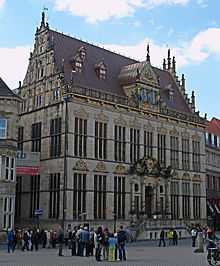Schütting (Bremen)





The Schütting, situated on the Marktplatz (market square) in Bremen, Germany, initially served the city's merchants and tradesmen as a guild house. In 1849, it became Bremen's chamber of commerce. Since 1973, it has been a listed building.[1]
Building history
On the site of a building first mentioned in 1444, the merchants of Bremen constructed a new building in 1538 in the delicate Renaissance style of Flanders. Its stepped western and eastern gables still stand, the latter crafted in 1565 by a local mason. In 1594, the cornice overlooking the market square was enhanced by a magnificent maritime gable. In the 18th century, the facade was altered several times: in 1818, the entrance which originally was located at the left side of the building was replaced by a portal at the centre while further improvements were made from 1895 to 1899. In 1899, the Low German inscription
- buten un binnen
- wagen un winnen
(literally "Outside and in, risk it and win") was added as a motto, meaning that merchants from Bremen are called upon to risk their assets at home and abroad in order to gain fortune. The motto was created by mayor Otto Gildemeister.[2]
The building with its magnificent interior and its valuable furnishings burnt to the ground on 6 October 1944. Reconstruction was completed in 1956. Except for the dormers on the facade overlooking the market square, the exterior was rebuilt in the original style while the interior was reconfigured. In 1951, the chamber of commerce moved into the ground floor. The second stage of the reconstruction took place over the next five years, including the second floor interior. In 2009, the faҫade and copper-covered roof were repaired and the dormers were rebuilt. The firm which performed the work received an award in 2010 from the Landesamt für Denkmalspflege (State of Bremen office for the preservation of monuments and historic buildings).[3]
The name Schütting
The first house of the merchants was a middle-class house in Langenstraße on the corner with Hakenstrasse which was bought in 1425 and sold in 1444. When the building at the southern side of the market was purchased in 1444, the name Schütting was used for the first time. It is interpreted in various ways:
- In Bergen (Norway), the name Scotting denominates a building for merchants offering them protection and warmth in winter time. The name is related to the German word schützen meaning "to protect".
- When the town hall was built (1405), the territory facing southwards which had been sloping downwards was levelled, up to the Balge. The German word “schütten” (to pour, to fill up) could have been the reason for choosing the name.
- Another more mundane explanation could be derived from the German word “schütten”: a place where the money is poured together for the guild of merchants.
- “collecting taxes and duties” was called “schossen” in medieval German; some interpreters point out that the word “schossen” is similar to “Schütting”.
In Oldenburg, the name Schütting was used in a corresponding manner when, in 1605, a building with a similar purpose was built.
Location and purpose of the building
The Schütting is situated at the southern side of the Marktplatz, directly opposite the Town Hall and the Roland.
The year 1451 saw the establishment of the organisation representing the merchants of Bremen. The relations between the merchants were regularised by a treaty named “Ordinantie”, dated 10 January 1451. Until 1849, the organisation bore the name of “Collegium Seniorum”. Thereafter, it changed its name to Bremer Handelskammer (Bremen chamber of commerce).
The first coffee house in the German-speaking countries came into being in Bremen in 1673. Its exact location is not known, but from 1679 onwards, it was located in the Schütting.[4]
In the basement of the Schütting, a traditional gentlemen's club, the “Club zu Bremen”, has its club rooms. Since the year 2000, it has been open to female members, too.
Sources
- This article incorporates information from the equivalent article on the German Wikipedia.
Literature
- Schwarzwälder, Herbert (2003). Das Große Bremen-Lexikon. Edition Temmen. ISBN 3-86108-693-X. (German)
- Lydia Niehoff: 550 Jahre – Tradition der Unabhängigkeit, Chronik der Handelskammer Bremen. Schünemann Verlag, Bremen 2001, ISBN 3-7961-1827-5.
- Peter Hahn: 450 Jahre Haus Schütting, Sitz der Handelskammer Bremen. Die Baugeschichte. Hrsg.: Handelskammer Bremen. Schünemann Verlag, Bremen 1988, ISBN 3-7961-1797-X.
- H. A. Schumacher: Zur Geschichte des Schüttings. In: Bremisches Jahrbuch. Band 5, Bremen 1870, S. 192–214.
References
- ↑ Database of Landesamt für Denkmalpflege Bremen #0072 (German)
- ↑ Kloos, Werner (1980). Bremer Lexikon - Lemma Buten un Binnen, Wagen un Winnen. Hauschild Verlag Bremen. ISBN 9783920699318. (German)
- ↑ "Verleihung des Bremer Denkmalpflegepreises 2010". Landesamt für Denkmalpflege. Retrieved December 5, 2013.
- ↑ Niehoff, Lydia (2001). 550 Jahre Tradition der Unabhängigkeit. Schünemann Verlag Bremen. ISBN 9783796118272. S. 92. (German)
External links
| Wikimedia Commons has media related to Schütting. |
- Official website (German) (English)
Coordinates: 53°4′32″N 8°48′24″E / 53.07556°N 8.80667°E